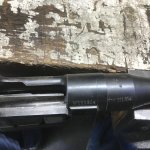Hi, I got this old Enfield Model P17 a few moons ago, literally, from the Farmer up the road, & literally, it's been in the Barn for several decades.
Other than the barrel being VERY rusty, & overall, somewhat rusty-ish. (I'm soaking it as we speak) I was able to remove the bolt, work the action, squeeze trigger etc. It's not great, but, everything moved & was smooth.
I search here 3 years back..not much on these.
I'm not a Milsurp guy, I was thinking to do this right, get a nice stock for it etc. but, not sure, & not sure about the barrel.
Here's the Markings on it, & the first few Markings of serial # {W13 ----)...All Serial #'s Match, as in Barrel, Bolt, Receiver.
Just wondering the probable History on this piece,
& Any info on it would be greatly appreciated, as I know very little on the topic, & not allot info on here or on Canadian sites, selling them, or selling parts for them.
Thnx in Advance!



Other than the barrel being VERY rusty, & overall, somewhat rusty-ish. (I'm soaking it as we speak) I was able to remove the bolt, work the action, squeeze trigger etc. It's not great, but, everything moved & was smooth.
I search here 3 years back..not much on these.
I'm not a Milsurp guy, I was thinking to do this right, get a nice stock for it etc. but, not sure, & not sure about the barrel.
Here's the Markings on it, & the first few Markings of serial # {W13 ----)...All Serial #'s Match, as in Barrel, Bolt, Receiver.
Just wondering the probable History on this piece,
& Any info on it would be greatly appreciated, as I know very little on the topic, & not allot info on here or on Canadian sites, selling them, or selling parts for them.
Thnx in Advance!



Last edited:













































































